With concealed cooker hoods becoming big news in kitchens, does that signal the end of the road for all statement extraction?
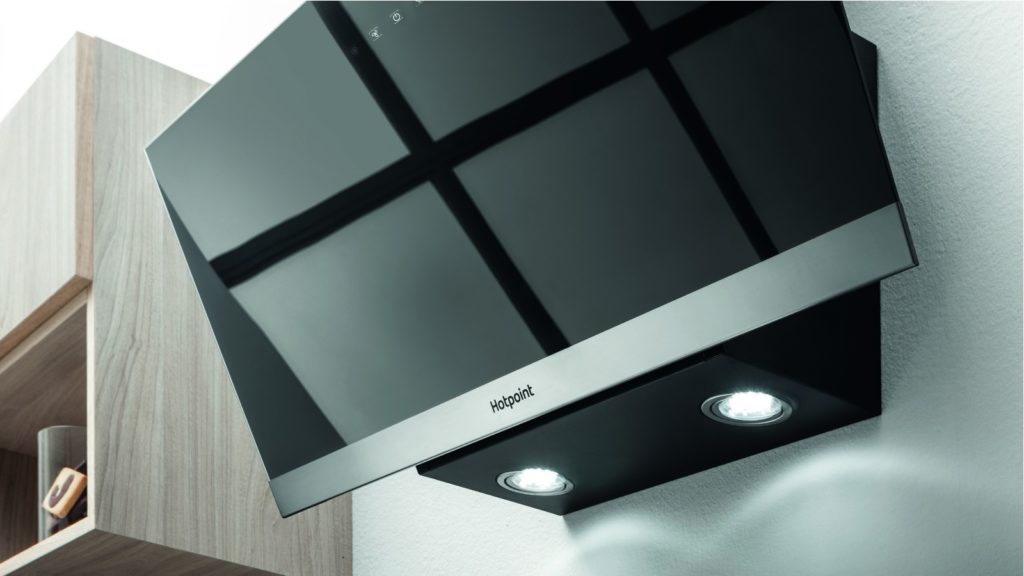
The Hotpoint PHVP 8.7LT K vertical glass hood offers air extraction at 713m3/h and operates at 68dB. It features three speeds, a washable filter, and two LED lights
Downdraft extractors and all-in-one venting hobs may have recently captured the imagination of kitchen designers but that doesn’t mean it’s the end of the road for focal cooker hoods. Far from it, in fact.
While, arguably, they may not be the media darlings in the spotlight of kitchen extraction, focal cooker hood sales are supported at all levels of the market, from price-conscious newbuilds to luxury kitchen schemes.
Sponsored Video
According to country manager at Novy UK Owain Harrison, focal extraction still accounts for 40% of all cooker hood sales.
And it’s a market that is continuing to grow, as senior brand manager for Hotpoint Catherine Balderson says: “Between 2017 and 2018, the cooker hood category witnessed a growth in sales of 2.6%”, and stated extraction is “one of the biggest drivers of sales across the cooking appliance category.”
Supported by newbuild
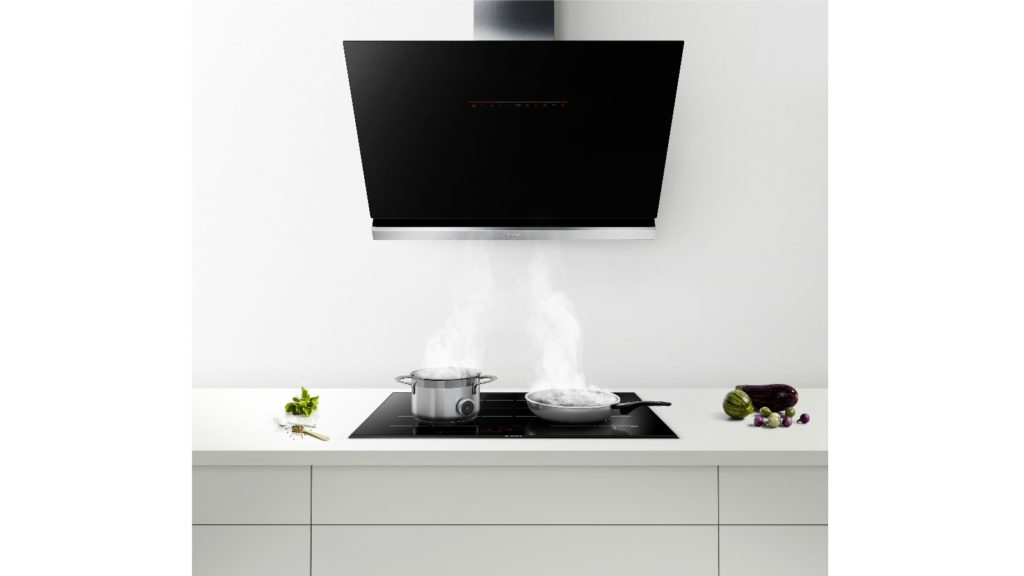
The DWK98PR60B from Bosch is a 900mm wall-mounted cooker hood which has an extraction rate of up to 837m3/h. It features hob to hood control and can be checked remotely using the company’s Home Connect App
Catherine Balderson of Hotpoint continues: “UK building regulations state that new homes must have an effective method to remove steam and condensation from the kitchen to avoid the development of mould. Newly-built homes, therefore, must incorporate kitchen extraction.”
While downdrafts could be price prohibitive for some developers seeking cost-effective extraction, focal cooker hoods can be a solution.
In the lower to mid-market sector, focal extraction can add perceived value. It t is probably why marketing manager of CDA Steve Corbett comments: “Chimney extractors remain the best seller in the market and there are still a lot of customers out there who aspire to the stainless steel chimney when a kitchen is replaced – often either never having had an extractor before or had an old, noisy and often ineffective machine that mad a lot of noise and did not extract effectively.”
Luxury island looks
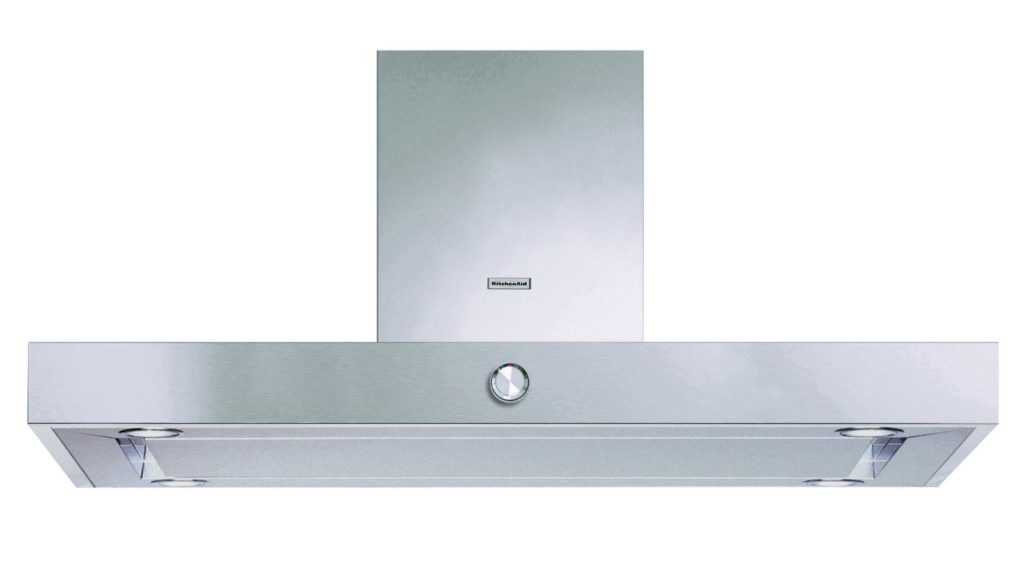
Measuring 1200mm, the KEIPP 12020 island hood from KitchenAid is made from anti-fingerprint stainless steel and offers an extraction rate of up to 779m3/h. In uses peripheral extraction and comes complete with four LED lights
However, it should be pointed out that focal cooker hoods are not simply for the cost-conscious market, nor are they simply based on the tradition ‘T’ shape.
With a vast array of styles, they can be a first choice for consumers. It may be that the designer or their client doesn’t want to lose the cupboard space, associated with downdraft extractor or venting hob.
Equally, they may want it as a talking point above a kitchen island. Think pendant extraction.
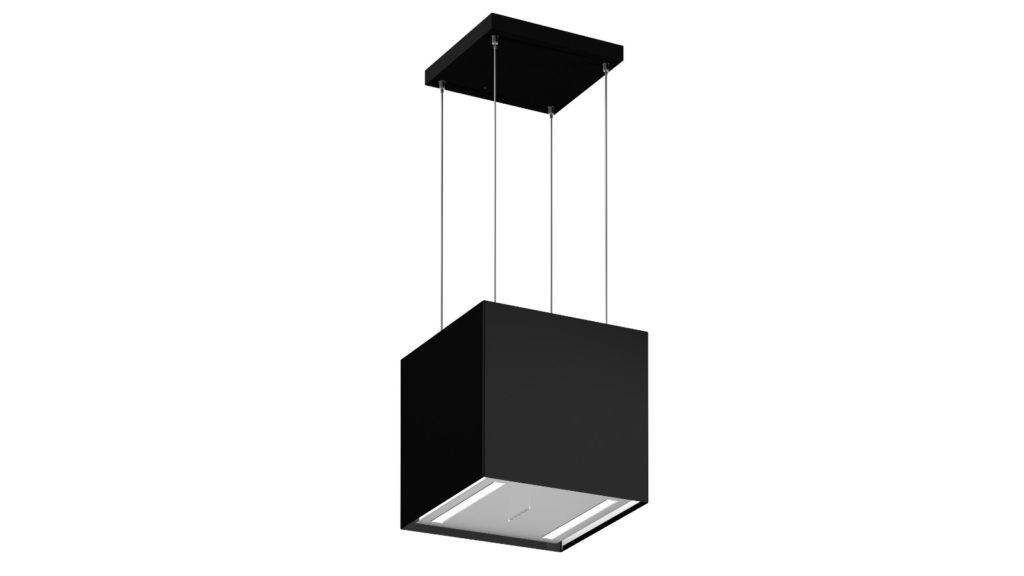
The KUD40PRO1XA cooker hood from Bertazzoni is designed for an island and can raise and lower by 400mm. It has an A+ energy rating, can extract up to 620m3/h and operates at 71dB
Product manager of Caple Luke Shipway explains the design ethos of focal extraction in a kitchen with an island: “Focal extraction can be best used to create a statement in an integrated kitchen. Island hood designs tend to be dramatic to create a strong focal point in the central island where food may be prepared and cooked and guests entertained.”
And Catherine Balderson of Hotpoint agrees, commenting: “Many consumers opt to install a focal hood above their island, bringing professional glamour into the kitchen and making an eye-catching statement. This has further resulted in a significant growth in market share for focal extraction.”
Hoods add illumination
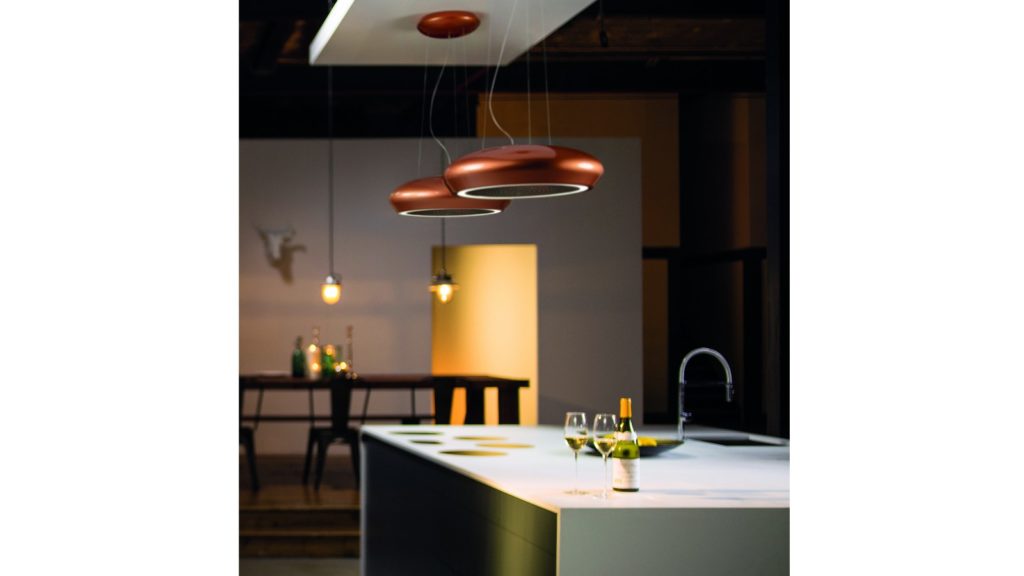
As its name suggests, the Ceramica Island Hood by Caple has a handmade ceramic body and comes in a copper finish. Designed for recirculation installations, the four-speed hood comes with a 20W LED light and remote control
Statement cooker hoods also provide the additional benefit of lighting, not only providing enhanced visibility for tasks but also soft mood lighting.
Owain Harrison of Novy UK explains: “There are many consumers and designers that still want to feature an overhead extraction option, not just for its ability to remove cooking vapours but for the stunning lighting choices that come with. LEDs often have adjustable settings to deliver different tones whether for task lighting or more understated mood lighting when socialising.
“The statement cooker hood nowadays is also equally considered for its ability to provide ideal illumination in the kitchen space.” And Steve Corbett of CDA agrees: “The extractor is also part of the lighting scheme in most kitchens.”
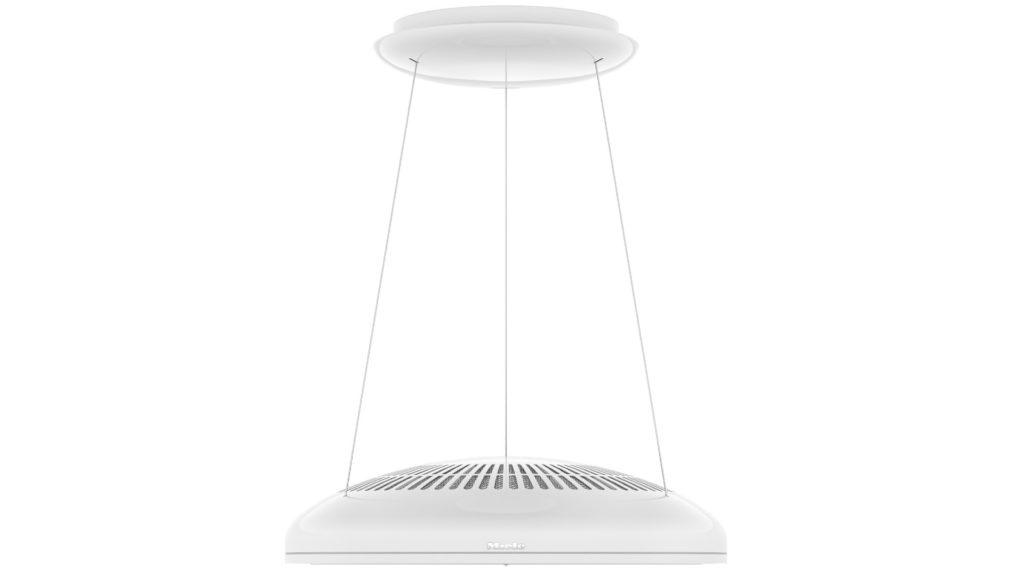
Forming part of Miele’s G7000 appliance collection is the DA7078 Aura 3.0 Cooker Hood. It features integral lighting and a scent function, as well as hob to hood Con@activity function
In fact, such is the demand for the extractor to provide lighting; it has been a design focus of extraction produced by Wave, as its managing director Vincent van den berg points out: “You only have to look at the developments in lighting to see that the real pursuit is for stunning and beautiful product design.
“We’ve married together these trends – the functional qualities of a high performing extractor with the beautiful design of interior lighting. Our high performing extractors can be cleverly combined as a stunning light while being prominently on display.”
Blurring design boundaries
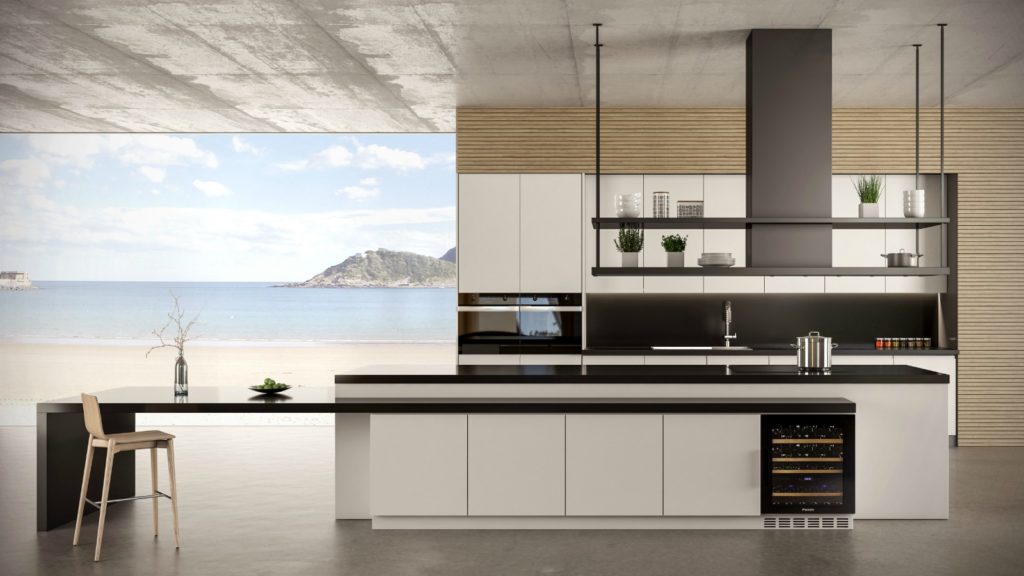
The AdaptPro I-898 from Pando can be custom-built with flexible positioning of the extractor chimney and choice of single or double shelf. It comes in a choice of colours, with LED lighting and Airlink hob to hood connectivity
Combining extraction with lighting begs the question has there been a blurring of lines between concealed hoods and statement pieces?
The cooker hood can now form an intrinsic part of the architecture of the kitchen, especially with the trend for industrial style projects.
Vincent van den Berg of Wave comments: “We’ve developed an industrial mounted frame which houses the extractor and acts as a statement piece with standard sizes up to 3000mm in length. The frame can be in stainless steel, black or in a customer specific colour in matt or gloss finishes and in any size they want.
“This is a product which is more than an extractor. It epitomises the industry trend and gives retailers the ability to add a distinctive element to their kitchen design.”
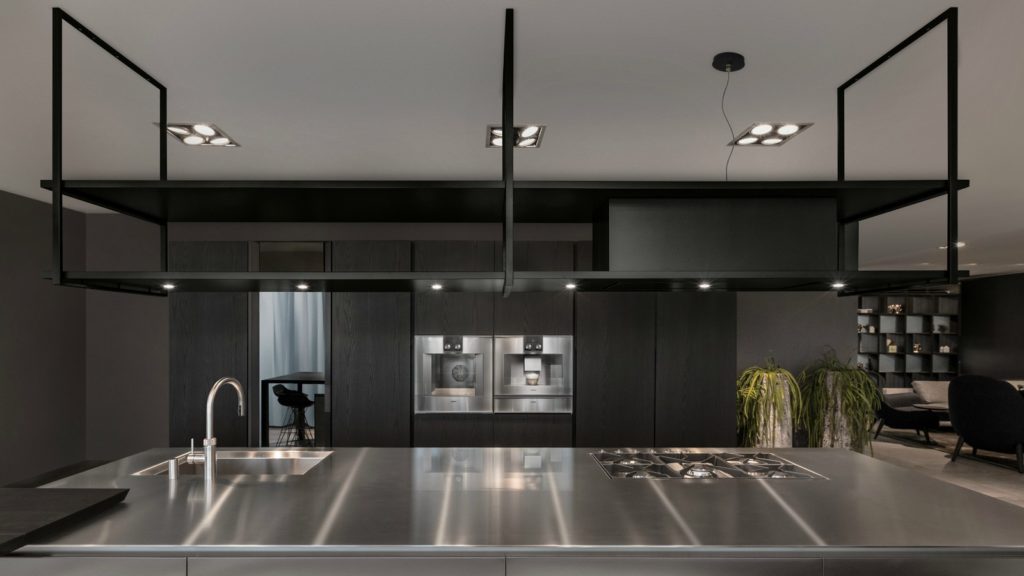
Ranging in size from 2400mm up to 3000mm, the frame of the Wave 2055 can be specified in stainless steel, matt black or a choice of matt or gloss finish colours. Retailers can also choose carbon or plasma filters
In addition with the latest Lift & Rise extractors from BSH Home Appliances, the statement extractor can be concealed when not in use.
Product manager for ventilation at BSH Home Appliances Adam Norris adds: “our Siemens varioLift ceiling hood does somewhat blur the boundaries between statement and integrated solution, offering additional flexibility in terms of installation.
“It isn’t intrusive when not in use, but when you’re cooking it creates real theatre in the kitchen, adding a ‘wow’ factor and a unique sense of style.”
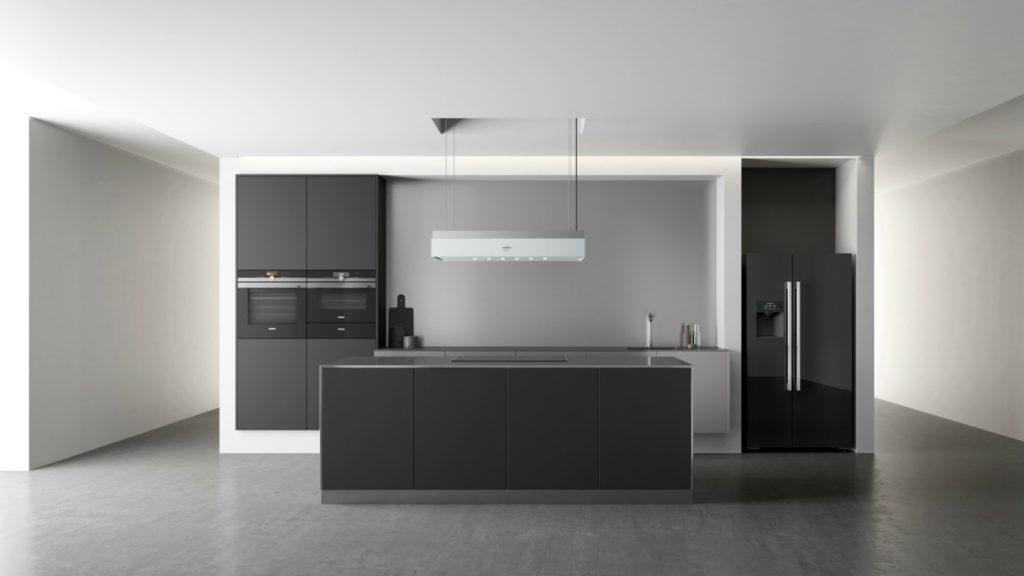
The Siemens studioline Variolift ceiling hood can be lowered for cooking and raised to integrate into the ceiling when out of use. It features CookConnect hob to hood connectivity and can be operated by voice control
Functionality comes first
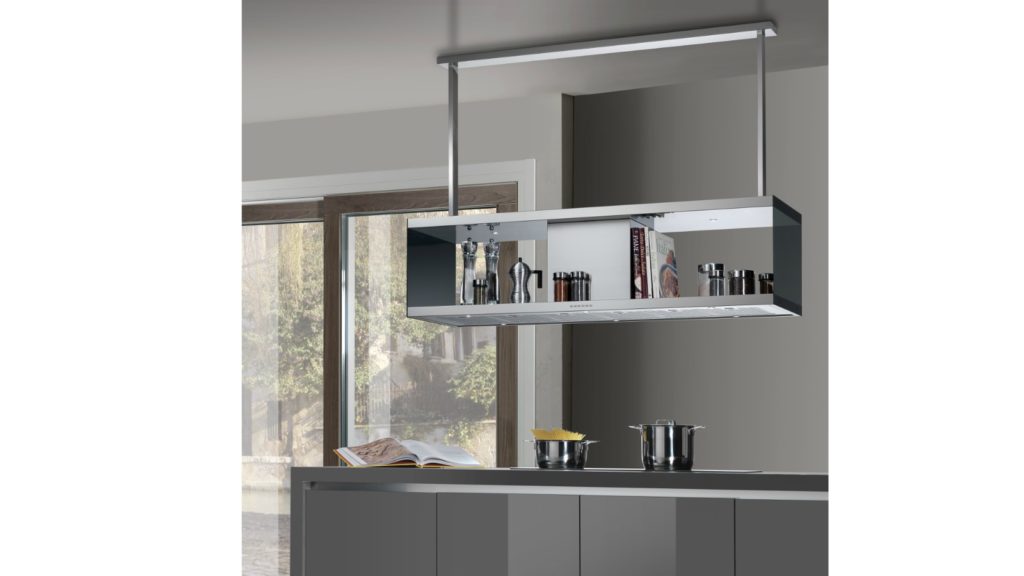
Rossini by Airuno provides storage as well as extraction with a shelving design which measures 1000mm long. It has LED lighting and comes in a stainless steel and glass finish
But while aesthetics may play a key role in the choice of a statement extractor, industry experts are also keen to remind kitchen design professionals that functionality must come first.
Brand manager of Indesit Sara Bazeley points out: “Hoods should be considered not only for their appearance but also their performance.
“It has to be practical, fit in with the needs and lifestyles of the household and the design of the kitchen, as well as perform powerfully and quietly, creating and maintaining a comfortable environment for the user.”

The EZA60 BL from Caple is a wall-mounted model which has three speed, plus an intensive timer mode, and can be used for ducted or recirculated installation
And channel controller of KitchenAid Lee Collett agrees, adding: “Ducted installation ensures better extraction performance and should always be the preferred option for the luxury kitchen, where it is possible.
“In addition to removing odours and grease, ducted installation ensures moisture is also removed from the air.
“By opting for ducted installation, the air is removed from the home, furnishings are protected and air quality is dramatically improved.”

Part of Indesit‘s Aria range of built-in cooking appliances is the angled black glass cooker hood. It features LED lighting and has an extraction rate of 647m3/h
However, Vincent van den Berg points to a new generation of recirculation extraction, as he states: “As well as the aesthetics of the extractor, there will be a continued focus on improving the performance of extractors.
“This is especially critical as kitchens become more integrated into the home environment. While most retailers know about recirculation, they might only be aware of recirculation using carbon filters.
“These tend to have inferior functionality which has led to poor reviews. Plasma filters are a new type of filter. They are equal to – and even outperform – ducted extractors.”
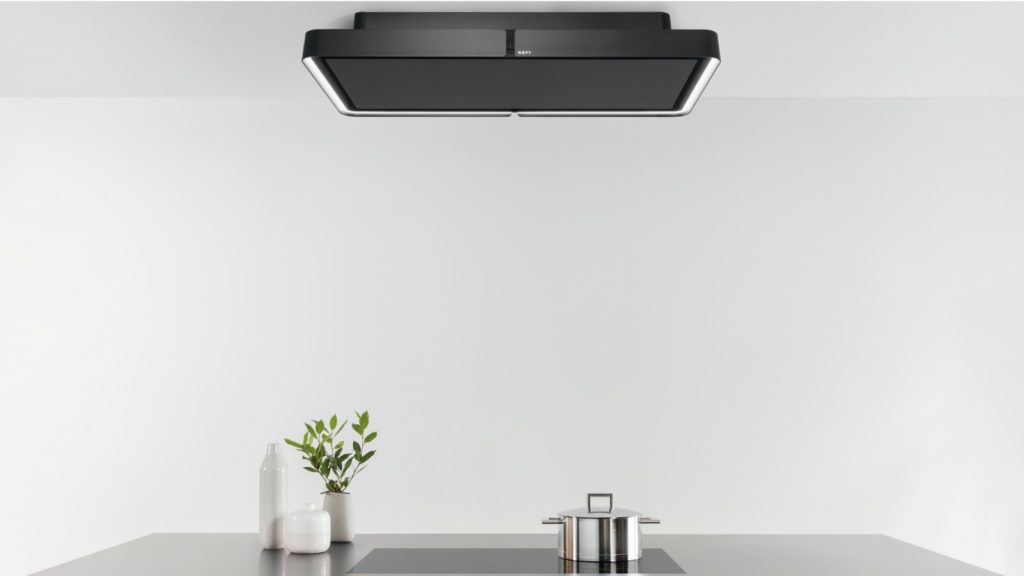
The Novy Cloud ceiling hood is designed to work with recirculation, rather than ducted, installations. The four speed hood boasts ambient lighting and operates at 36dB up to 53dB
And, of course, as connectivity becomes more commonplace, chairman of Airuno Geoff Baker adds: “Cooker hoods that feature hob-to-hood technology which connects the hob and hood wirelessly, allowing the hood to operated automatically and only when necessary – should perform well.”
So when specifying kitchen cooker hoods, perhaps don’t naturally steer towards concealed extraction but consider the looks and functionality which statement hoods can deliver.



